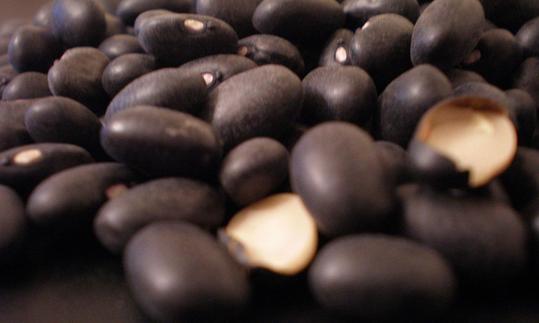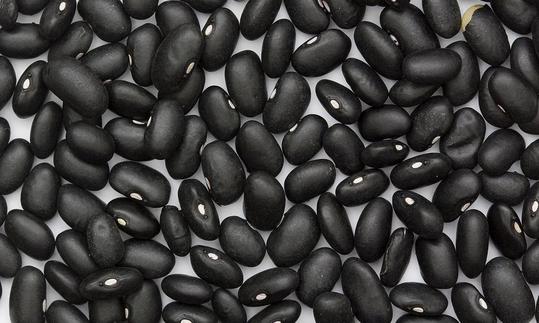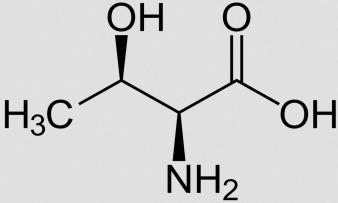Table of contents
Black beans are a variety of the common bean ( Phaseolus vulgaris ). They are rich in fiber and protein.
Use in the kitchen
The narrow, round beans with a shiny, black skin have a slightly spicy, nutty taste. Unlike other types of beans, they are waxy. They are popular in Latin American cuisine, where they are traditionally eaten with long-grain rice or corn semolina (polenta). Well-known national dishes are feijoada, moros y cristianos and gallo pinto.
Like other legumes, black beans must be cooked or sprouted before consumption. They should be soaked in water for several hours (overnight) beforehand so that the phytic acid they contain can break down. More on this here: " Phytic acid or phytate and soaking or sprouting ".
Because they take longer to cook, it's worth cooking the beans separately and then adding them to different dishes. They go well in stews, for example with tomatoes , yellow bell peppers , chili peppers , corn , spinach or chard . They can also be used to make patties or bean burgers . Cooled, cooked black beans go well in raw salads or you can use them to make a dip or bean sauce.
Vegan recipe for black bean salad with tomato
Ingredients (for 4 people): 200 g dried black beans, 2 cloves of garlic , 1 green bell pepper , 1 beef tomato , 1 red chili pepper , 1/2 bunch of fresh coriander leaves , 3 tbsp lime juice , 3 tbsp rapeseed oil , salt ,black pepper .
Preparation: Cook the beans (see cooked black beans). Put the beans in a large bowl. Peel the garlic and press it with a garlic press or chop it finely. Add to the beans and season with a little salt. Wash the vegetables and deseed the bell peppers and dice them together with the tomatoes. Halve the chili peppers and deseed them, then cut them into thin slices. Mix into the bean mixture. Wash and finely chop the coriander leaves if necessary. Add the lime juice and oil, mix well and season with salt and pepper.
Vegan recipes with black beans can be found under the note: " Recipes that have the most of this ingredient ".
| Not only vegans or vegetarians should read this: Vegans often eat unhealthily. Avoidable nutritional mistakes . |
Purchasing - Storage
Black beans can be bought dried or cooked in jars or tins, sometimes even in organic quality. They are available all year round . They can sometimes be bought in large supermarket chains such as Coop , Migros , Spar , Rewe , Edeka or Hofer . Other supermarkets such as Aldi , Denner , Volg , Lidl and Billa rarely have them on offer. Black beans are also available in organic supermarkets such as Denn's Biomarkt or Alnatura or in health food stores.
The availability of black beans in the supermarkets mentioned varies depending on the size of the store, catchment area, etc. If you are interested, click on our recorded food prices for the DA-CH countries (above under the ingredient image). There you will find current prices from various supermarkets and their price development.
Storage tips
Dried black beans can be stored in tightly sealed jars or cans, or in the original packaging, in a dry place for one to two years. 3
Ingredients - Nutritional values - Calories
Black beans (organic) contain 341 kcal per 100 g. They are very rich in fiber with 16 g/100g of dietary fiber. 100 g of beans contain 22 g of protein and 62 g of carbohydrates. The fat content is low at 1.4 g/100g. 1
They contain plenty of folate (folic acid) . The 444 µg of folate per 100 g of beans correspond to 222% of the daily requirement. However, cooked black beans only contain 149 µg/100g, which corresponds to 75% of the daily requirement. Cooked kidney beans (130 µg), cooked white beans (102 µg) and cooked lentils (181 µg) have similar values. 1
The protein-rich beans contain all eight essential amino acids. Tryptophan and threonine are abundant, with 0.26 g and 0.91 g per 100g respectively. Isoleucine , lysine , phenylalanine , leucine , valine and methionine are also present, but in smaller amounts. 1
Potassium is also plentiful at 1,483 mg/100g. However, this is lost in the water during washing and cooking, which is whycooked black beans only contain 355 mg/100g. Broad beans also contain plenty of potassium at 1,062 mg/100g. Unlike black beans, these can be eaten raw in small quantities. Potassium is also plentiful in cooked soybeans (515 mg), raw spinach (558 mg) and lamb's lettuce (459 mg). Bananas , which are often cited as a good source of potassium, only contain 358 mg/100g. 1
The complete ingredients of black beans, the coverage of the daily requirement and comparison values with other ingredients can be found in our nutrient tables. In the article Nutrients explained you will get a detailed insight into the topic.
Effects on health
Black beans contain a lot of folic acid. This is involved in important metabolic reactions (DNA and RNA synthesis). Too little can cause genetic damage. Folic acid is also important for the development of the central nervous system. Folic acid is particularly important for women who want to have children. The German Nutrition Society recommends that women should increase their folic acid intake before pregnancy (requirement 600 µg) to prevent birth defects in the newborn. 8 Eating foods containing folic acid, such as beans, reduces the risk of pancreatic and colon cancer. 10 However, too many artificial folic acid preparations can increase the risk of developing cancer. 11
Black beans are also rich in phytochemicals that have anti-inflammatory and antioxidant effects. For more information, see the link to the ingredientBlackbeans, cooked without salt.
Dangers - Intolerances - Side effects
Black beans, like all varieties of common beans, are harmful when raw because they contain several substances that are incompatible with humans, including the lectin phasin (phytohemagglutinin), phytic acid and protease inhibitors. These so-called anti-nutrients can be reduced by soaking them in water for several hours and then cooking or sprouting them so that the beans can be eaten. Read more about this in the article on phytic acid .
The polysaccharides (oligosaccharides) contained in the beans are indigestible for humans. However, intestinal bacteria can break down the raffinose and stachyose through bacterial fermentation, which produces gases as a by-product, which can lead to bloating and flatulence. People who eat small amounts of fiber tend to react more sensitively, and it is therefore better to increase the amount of dietary fiber gradually. It has also been shown that not every type of bean has the same reaction, which is why it is worth trying out different varieties. 12 To reduce the polysaccharides and phytic acid, the raw beans should be soaked in water overnight before cooking and the soaking water thrown away. Some also say that adding baking soda makes the beans more digestible. 13 Spices such as savory , fennel seeds , anise , coriander seeds , cumin seeds, and caraway seeds aid digestion and relax the intestinal muscles, which is why they can relieve flatulence. In case of gastrointestinal intolerance to oligosaccharides, it is possible to take the enzyme α-galactosidase, which breaks down raffinose into sucrose and galactose, orally. However, this should not be done without medical advice . Beans, like other legumes, contain relatively high levels of purines, which is why people suffering from gout or nephritis should avoid them. 13
Ecological footprint - animal welfare
Despite extensive research, we were unable to find any specific data on the ecological footprint in terms of CO 2 emissions and water consumption for the production of black beans. The following information therefore refers to pulses such as beans, chickpeas , soybeans , lentils and peas. These are considered healthy plant-based protein sources due to their high protein content and fiber. They have a better environmental impact than milk and meat products. Their ecological footprint is smaller because they require less arable land and water and have fewer CO 2 emissions. It is therefore more environmentally and climate-friendly to eat plant-based proteins in the form of pulses than meat and milk products. In addition, many calories are lost during meat and milk production because more plant calories have to be fed to the animals than are ultimately produced as animal calories. 16,17,18
In addition, pulses are an important part of crop rotation in organic farming. Through their symbiosis with the nodule bacteria in the soil, they can enrich the soil with between 50 and 100 kg of nitrogen per hectare per year. This is then available to subsequent plants. They are therefore an important pre-crop, especially for cereals. 19
The largest producer and consumer of black beans is Brazil, but they are grown in countries all over the world. China, Mexico, the USA, India and even individual regions in Germany grow this legume, among others. 20,21 Ideally, when shopping, you should look for regional, organically grown products, because organic farming does not use synthetic pesticides. In conventional farming, on the other hand, large quantities of herbicides (such as glyphosate) are used when growing legumes, and not just to control weeds. Desiccation, a practice to speed up the harvest, involves deliberately killing the crop using herbicides. This dries out the plant and the crop ripens more quickly. This is used primarily in countries where the growing season is too short, such as Canada, or simply as a time-saving measure. 22 Accordingly, there may also be an increased concentration of this agent in the end product, especially in legumes or grains. 23
Worldwide occurrence - cultivation
The common bean ( Phaseolus vulgaris ) originally comes from Central America and the Andean region of South America. For a long time it was assumed that there were two centers of domestication, but new research shows that the common bean was probably first domesticated in Mexico and later planted in the Andean regions. 4 In the 16th century, common beans were introduced to Europe. Varieties from Central and South America were planted. Over the centuries, Europe developed its own varieties through hybridization. 7
In international trade, no distinction is made between the individual varieties. According to FAOSTAT , 27.4 million tons of dried beans were produced worldwide in 2020. 2 Brazil is the largest producer and consumer of black beans with a product volume of 438,240 tons. 9
the wild
Found in Feral and wild forms of the common bean can be found in Central and South America, where the cultivated common bean originally comes from. 4 A wild parent form, Phaseolus aborigineus Burk., is still found in Venezuela, Colombia, Peru, Bolivia and central Argentina. 6,7
Cultivation - Harvest
Black beans can be planted in the bed or in a large pot. They prefer a sunny location and well-drained soil. The seeds germinate best when the soil is 20° C 2 , usually from May onwards is a good time for direct sowing. The bean seeds should be sown 3 cm deep and 15 cm apart from the next seed in the row. There should be 40 cm of space between the rows. Often not all beans germinate, so to be on the safe side you can always plant two beans directly next to each other. Then water well and keep moist during the germination phase. The black beans grow as bush beans, which is why they do not need a bean pole. Bean plants need more water during pod development. When the first flowers appear, you should start watering the plant more often. As soon as the pods turn yellow, you should reduce watering. This helps the seeds develop in the pods. 14,15
Black beans are grown to harvest the dried seeds, not like other types of beans to eat the unripe pods. That's why they take longer to ripen, about 95 to 105 days. Once the pods are straw-yellow to brown and dry, you can harvest the pods with the ripe seeds. The pods should be cut with scissors and not ripped off by hand, as this could damage the pods. The pods are then laid out to dry. This makes it easier to remove the seeds from the pods. To ensure that the beans are completely dry and will keep well, lay the seeds out in a dry place for at least two weeks. Cans or jars are suitable for further storage. 14,15
Further information
Black beans are a variant of the common bean ( Phaseolus vulgaris ). This belongs to the subfamily Faboideae. The pods of the common bean ( Phaseolus vulgaris ) can be flat or round in cross-section, and can be marbled in different colors such as green, yellow, purple or black. The seeds of the common bean also have different colors and shapes.
Alternative names
Black beans are called Black Turtle Beans in English-speaking countries, not Black Beans. In Spanish they are called Frjoles negros and in Portuguese Feijão Preto, which translates to black beans.










Comments